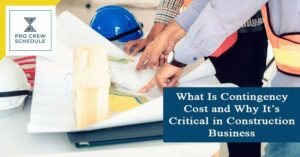In managing construction, risk planning is one of the most critical aspects stakeholders must highlight before the project commences. Incorporating a construction contingency in your overall budget is one of the first steps in protecting your company from any unforeseen risks throughout the project timeline. Remember: Risks equates to cost, and this cost needs to come from somewhere.
What is Contingency in Construction?
Generally, construction contingency is the amount set aside to cover any unexpected expenses throughout the construction period. This money is on hold and reserves and not allocated in any specific activity or work. In a nutshell, construction contingency acts as insurance against any unforeseen costs in the project task management.
The construction contingency serves mostly three essential purposes:
- To pay for errors or errors of omission in the construction documents;
- To change or modify the quality and scope of work;
- To compensate for any unknown conditions.
Deciding on the amount that must be allocated in construction contingency is considered a balancing act. On one side of the spectrum, you want to have a contingency amount to fund any uncertainties and events that may arise. On the other hand, you still need enough cash on hand to keep the construction going smoothly and efficiently. Typically, construction projects reserve a rate of 5 to 10 percent of the total budget for the project for contingencies.
Is Construction Contingency Same with Retainage?
While construction retainage and contingency are considered “emergency funds,” they are essentially not the same.
When something in the projects didn’t go as planned and cost some extra money, the payment for fixing the issue may come from the contingency fund, or it may also come from the retainage that is being withheld from the general contractor or subcontractor who created the issue in the first place. Furthermore, contingency and retainage both represent about 5 to 10 percent of the total construction price.
Generally, retainage means the amount of contract price earned by the contractors but remains withheld until the last phase of the construction project. Construction contingency, however, is the inflated amount from the contract price for the unexpected issues.
Construction retainage is the dollar earned and unpaid. That corresponding amount could be the difference between a construction company acquiring a healthy profit or losing money on a job. Contingency is the money not owned by anyone and could even turn into a plus if the contingency fund isn’t used and gets dispersed to the project stakeholders by the end of the project.
Why is Contingency in Construction Important?
Construction contingency is critical in risk management because of the inherent stress and pressure in every project. Everyone involved in a project is forced to meet specific timelines, budgets, plans, and resource schedules.
This means that there might be instances that decisions may be rushed in an effort to stay on time, budget, and plan. Doing this does not help make construction projects successful and underscores the importance of contingency in construction.
Construction contingency, as explained above, is your insurance that you and your company are able to handle the unexpected. It helps eliminate the unnecessary panic when there is a personnel shortage and the weather causes delays or an abrupt change in expected government funding.
When we discuss the construction contingency with the project owners, we are frequently asked a series of questions like the following:
- Shouldn’t the BOE or Basis of Estimate process prevent the need for construction contingency?
The answer is no since the Basis of Estimates (BOE) is only used to define resources, money, and time required to finish a construction project on schedule and budget successfully. Meaning it cannot account for the unexpected construction expenses.
Doesn’t value engineering help mitigate the need for contingency budget?
No, value engineering is only required to provide a detailed and clear analysis of the best way to meet the goals of a construction project.
Does construction contingency ensure safety against cost overruns?
Having a contingency reserved gives you the ability and the peace of mind to manage unexpected delays and costs, mitigating the chances of cost overruns for the projects. Still, the surefire guarantee against overruns in the budget is an independent professional review.
How can I make sure that this allocated 5-10 percent of money won’t be abused?
A fundamental factor in a successful construction project is a collaborative and trustworthy relationship between the stakeholders. Project owners should trust their team and their partners.
Does construction contingency cost inflate my overall budget?
No, the construction contingency helps you stay on schedule and budget.
In a general sense, the answers to these questions come down to having good construction crew management, collaborative relationships with the project stakeholders, a professional independent review company that works alongside you. There are no guarantees when it comes to contingency in any line of work. With the construction industry, not an exemption, but a contingency gives you an assurance that you can mitigate risk and prepare for the unexpected.
We want you to think of continency as a necessary factor in your construction planning and budgeting. This contingency allocation is not an extra add-on to cost– it’s an essential element of a professionally planned and managed construction project.
In fact, we would argue that any construction company that tells clients that they don’t need a contingency should not be trusted.
What are the Types of Construction Contingencies?
1. Design Contingency
The design contingency usually covers up to 10% of the total construction cost. While identified and calculated separately, the contingency cost should be allocated by the project owner in the project budget. The owner withheld the budget and reserved it for designers and architects to ensure that all desired work scope was met.
As the project’s construction evolves, the contingency is determined upon by the owner and transferred to the project budget. This should be finalized after proper checks and balances where the owner, designers, and cost consultant work together and decide when to use the contingency.
The design contingency should not be touched in accomplishing the project scope unless one of the following conditions applies:
• Original budget did not adequately consider the project requirements;
- Original budget did not recognize the potential inflation or price changes in the market from the time the project budget was finalized;
- Inadequate project information available when the budget was established;
The third issue is the one condition most likely to lead to design contingency expenses.
In general, the design contingency is used for:
- Solving unforeseen matters during the design period and allowing interfaces that may be changed later in the design process;
- Implementing a balance or buffer between the project scope and the budget, thus diminishing the need for cost-cutting that may devalue the project;
- Improving the project as recommended by the design team and agreed upon by the project owner during the design phase to alleviate “scope creep.” Robust design processes and solid decision-making should also be applied to reduce scope creep.
2. Contractor Contingency
A contractor contingency is a cost amounting to the contractor’s anticipated price for the project that would account for diverse risk factors that cannot otherwise be considered earlier on the Schedule of Values. This amount is set aside to cover any errors on behalf of the general contractor or subcontractor. Therefore, contractors consider these funds as spent money. Incorporating this extra funding into your Basis of Estimate (BOE) is the contractor accepting the fact that unforeseen costs are all part of the construction business.
3. Owner’s Contingency
An owner’s contingency is an amount reserved for modifications or additions in the original scope of the work. These types of contingencies are typically used in guaranteed maximum price (GMP) contracts. Revisions and mistakes are not always the fault of the contractor. Any changes that are not part of the initial bid will have to be paid by the owner through the funded contingency. Preliminary plans or owner direct change orders are the leading reasons for dipping into an owner contingency fund.
Once the project owner determines the contingency cost, the next step is generally managing construction projects’ operations. All three parties – designer, contractor, and owner – may view the contingency differently, causing management concerns.
Contingency funds are to be used mainly to satisfy the scope or to deal with unknown project conditions— not for additional scope. The architect and designers should guarantee that the documents are as complete as possible since the contingency is not supposed to be used to address late design decisions.
Key Takeaway
When encountering a contingency clause in your construction contract, it is critical to keep an eye out for a few points. First, it should include all the designer’s contingency, owner’s contingency, and the contractor’s contingency. Additionally, it should list any predetermined costs that the contingency should be covered by.
In order to guide you with handling any unexpected matters that may arise in construction processes, regular meetings, task tracking, and frequent check-ups with your stakeholder are a must. An established construction scheduling software, like Pro Crew Schedule, can help you foresee potential risks in specific phases in construction, giving you a better perspective on where contingencies might be used throughout the project timeline.







